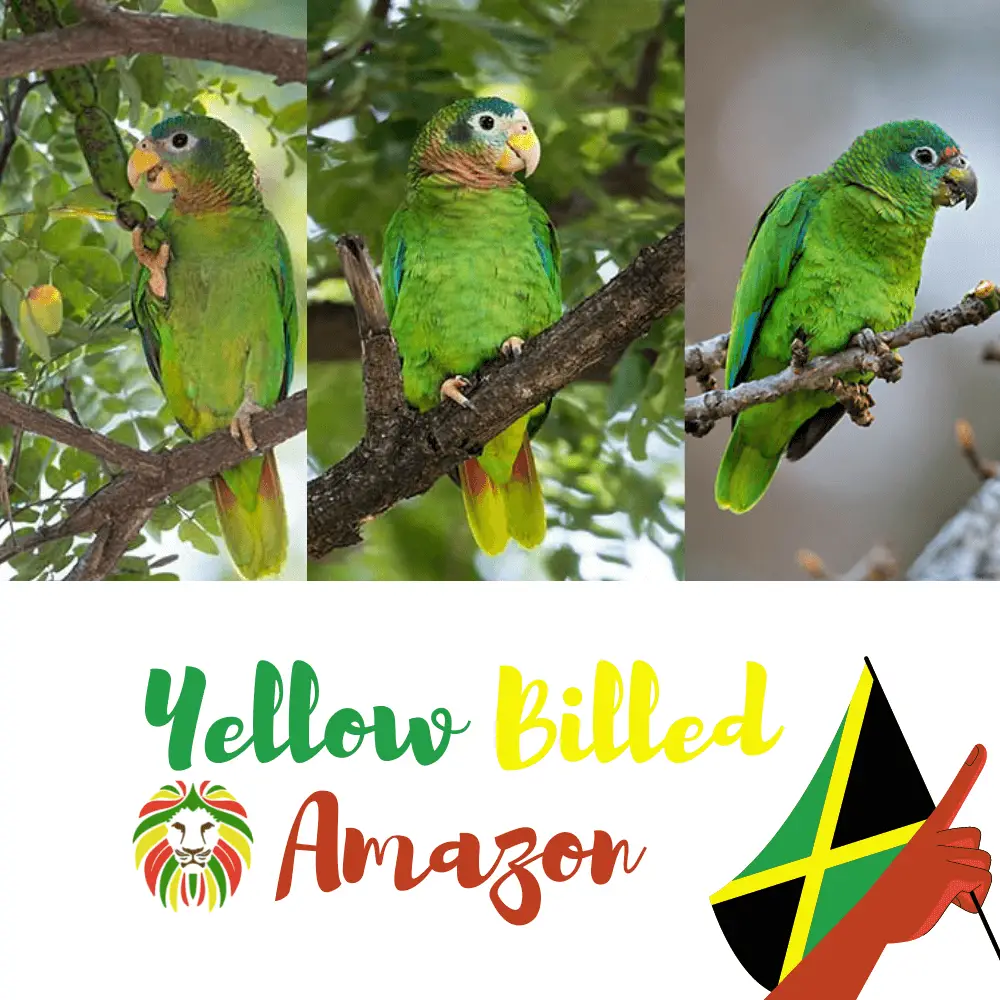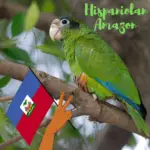
The Yellow billed Amazon or Sasabe Amazon or Amazona collaria is endemic to Jamaica where it frequents the humid forests of hills and mountains at medium altitudes. It feeds on various fruits and seeds, and other plant matter. It nests in cavities, often holes in trees.
The Sasabe Amazon is threatened by habitat destruction and the illegal trade in ornamental birds. The species is currently Vulnerable.
Description of the bird
Some measurements :
Length : 28 cm
The Sasabe Amazon has green plumage on the whole, with feathers with black stripes from the cap to the mantle and on the sides of the head. On the top of the wings, the primary and secondary remiges are blue. The top of the tail is green with a narrow yellowish terminal band. The outer rectrices are bordered with red. The rump and supracaudal covers are yellowish-green.
On the lower parts, the chest is green while the abdomen and subcaudal covers are yellowish-green. The tail has a large reddish base and a yellowish tip. The sub-wing covers are green. The remiges are pale blue-green. The tips of the wings are blackish-blue. The chin, throat, and sides of the neck are pink.
The head, the forehead, and the area around the eye are white. The anterior part of the cap is dull blue, while the lores and upper cheeks are light blues. Ear blankets are greyish-blue. The lower part of the cheeks is pale pink.
The hooked beak has a yellow base and whitish tip. The eyes are dark brown, surrounded by a white eye circle. The paws and fingers are pink with black claws.
Male and female are identical.
The juvenile/immature resembles the adult, but it has the base of the beak and lower mandible yellow, while the upper mandible is greyish. The plumage is green overall, including below. The head is mostly green with a few red feathers on the bottom of the forehead at the base of the beak, and a blue-green tint around the eyes and on the ear covers. The eye circle is white.
Geographical Distribution
The Sasabé Amazon is endemic to Jamaica. She is present at Cockpit Country, Mount Diablo, and the John Crow Mountains. A small population is established at Hope Gardens in Kingston.
Habitat
The Sasabé Amazon is usually found at medium altitudes, up to 1200 meters, but it is also present at sea level where it frequents slightly wooded habitats and cultivated areas. However, it is mostly present in humid forests on hills and in the mountains.
During the breeding season, it is often confined to closed forests. Outside this period, it feeds into more open spaces.
Screams and songs
The Sasabe Amazon in-flight emits a “tuk-tuk-tuk-teach” trumpeting with the last syllable longer. When laid, it produces a high-perched “tah-tah-keep”. But low and rolled giggles are also part of the repertoire.
Behaviors in wildlife
The Sasabé Amazon feeds on various fruits, berries, seeds, flowers, and buds. It is sometimes referred to as harmful to gardens and crops. It also consumes cultivated fruits.
It feeds halfway up and at the top of the forest. It usually forms large troops outside the breeding season and the birds meet in common dormitories at night. They leave them at sunrise after shouting together for a long time. They disperse and travel long distances to reach feeding sites.
Inside these feeding groups, we notice some Amazon parrots perched on top of the trees on uncovered branches. They are sentinels ready to warn the troop in case of danger.
They usually feed in the morning and late afternoon. They return to the dormitory at dusk.
The Sasabe Amazon remains inside closed forests during breeding. Like the majority of Psittaciformes, it nests in cavities, often tree holes.
She is a resident of Jamaica, but she wanders extensively for food.
It flies with slow, shallow beats, with the wings below the level of the back.
Breeding of the species
The breeding season is from March to July, although young has also been observed in October.
The Sasabae Amazon nests at the top of a tree, usually in a hole in the trunk, or in a nest abandoned by a woodpecker, and sometimes in a rock crevice. The nest is often placed at least 18 meters high.
The female lays 3-4 white eggs, and incubation lasts 24-25 days, probably shared by both adults. The period at the nest is long and can last up to 10 weeks.
Related Articles:




















